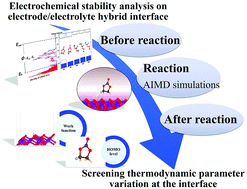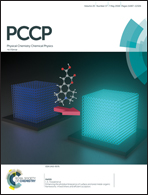First-principles study on thermodynamic stability of the hybrid interfacial structure of LiMn2O4 cathode and carbonate electrolyte in Li-ion batteries†
Abstract
The solid electrolyte interphase (SEI) of Li-ion batteries (LIBs) has been extensively studied, with most research focused on the anode, because of its significant impact on the prolonged cycle life, initial capacity loss, and safety issues. Using first-principles density functional theory (DFT) calculations and ab initio molecular dynamics (AIMD) simulations with the Hubbard correction, we examine the thermodynamic structure prediction and electrochemical stability of a spinel LiMn2O4 cathode interfaced with a carbonate electrolyte. The electronic energy levels of frontier orbitals of the electrolyte and the work function of the cathode offer clear characterization of the interfacial reactions. Our results based on both DFT calculations and AIMD simulations propose that the proton transfer mechanism at the hybrid interface is essential for initiating the SEI layer formation on the LiMn2O4 surface. Our results can be useful for identifying design concepts in the development of stable and high capacity LIBs with optimized electrodes and high-performance electrolytes.



 Please wait while we load your content...
Please wait while we load your content...